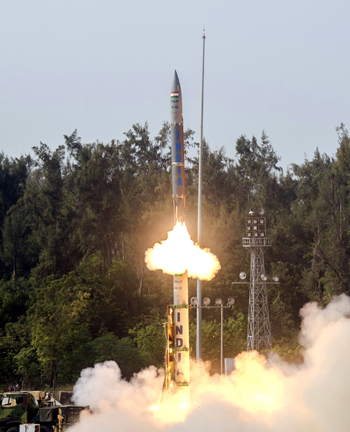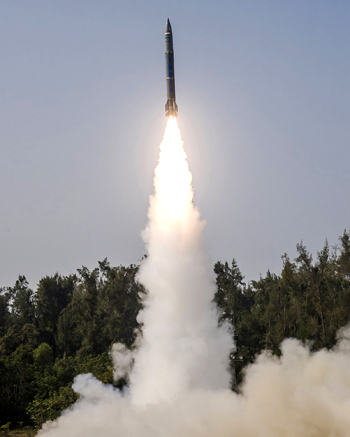INDIAN ARMED FORCES CHIEFS ON
OUR RELENTLESS AND FOCUSED PUBLISHING EFFORTS

SP Guide Publications puts forth a well compiled articulation of issues, pursuits and accomplishments of the Indian Army, over the years

I am confident that SP Guide Publications would continue to inform, inspire and influence.

My compliments to SP Guide Publications for informative and credible reportage on contemporary aerospace issues over the past six decades.
- Interim Defence Budget 2024-25 — An Analysis
- Union Defence budget 2024
- Indian Army: In quest of greater firepower and policy recommendations for gaps
- Indian Army Annual Press Conference 2024
- 6G will transform military-industrial applications
- Tata Boeing Aerospace Delivers 250 AH-64 Apache Fuselages, Manufactured in India
Pralay Ballistic Missiles for Army
India is upgrading its border security with the acquisition of Pralay precision missiles
 |
The Author is Former Director General of Information Systems and A Special Forces Veteran, Indian Army |

According to news reports of September 18, 2023, the Defence Acquisition Council (DAC) headed by Defence Minister Rajnath Singh in the Ministry of Defence (MoD) has approved the procurement of a regiment worth of 'Pralay' ballistic missiles for the Indian Army. These missiles reportedly would be deployed along the Line of Actual Control (LAC) and Line of Control (LoC) along China and Pakistan borders respectively. A defence official told media, "This is a major decision for the Indian Army as the proposal to acquire a regiment of the Pralay ballistic missiles which can hit targets between 150-500 Km, was cleared by the recent Defence Acquisition Council meeting."
Defence Minister Rajnath Singh leads approval of 'Pralay' ballistic missiles, a game-changer for Indian Army's border defence strategy
A report by ANI has quoted a source to say, "Both China and Pakistan have ballistic missiles which are for tactical roles. The 'Pralay' missile, developed by the Defence Research and Development Organisation (DRDO), is being further developed and its range can be extended significantly if the forces want to."
Pralay, which means Apocalypse in English, is a canisterised tactical surface-to-surface short-range ballistic missile (SRBM) developed by the Defence Research and Development Organisation (DRDO). The Project to develop 'Pralay' SRBM was sanctioned in March 2015 with a budget of 332.88 crore, which in year 2023 is equivalent of 500 crore or $63 million. Pralay missile is an amalgamation of technologies developed for exo-atmospheric interceptor missile Prithvi Defence Vehicle (PDV) from the Indian Ballistic Missile Programme and the 'Prahar' tactical missile developed indigenously.
Developed by DRDO, 'Pralay' boasts a formidable range of 150-500 km, enhancing India's tactical capabilities along China and Pakistan borders
Research Centre Imarat (RCI) is the lead integrator in Project 'Pralay'. Powered by solid fuel rocket motor, the missile follows quasi-ballistic trajectory and is able to perform mid-air maneuvers using maneuverable re-entry vehicle (MaRV) to defeat anti-ballistic missile (ABM) interceptors. Pralay uses the same composite propellant developed by High Energy Materials Research Laboratory (HEMRL) for the 'Sagarika' and 'K Missile' family. The composite propellant is highly efficient and generates more energy compared to the propellant used in the 'Agni' missile series.
Pralay carries 350 kg to 700 kg high explosive performed fragmentation warhead, penetration-cum-blast (PCB) and runway denial penetration sub-munition (RDPS) at a range of 150 km to 500 km. The missile is designed to target radar and communication installations, command and control centers and forward airfields using conventional warheads. The Pralay missile system is road mobile and meets the tactical ballistic missiles requirement of the Indian Army. It fills the gap of a conventionally armed ballistic missile that is outside the purview of the 'No First Use' nuclear policy. As mentioned above, the DRDO is working on extending the missile range beyond 500 km; by another few hundred km.
Powered by cutting-edge technology, 'Pralay' employs mid-air maneuvers and a maneuverable re-entry vehicle, outsmarting anti-ballistic missile interceptors

Specifications of the Pralay missile system include: mass – 5 tonnes; length – 7.5-11m; diameter – 520 mm, within 750mm; warhead – high explosive performed fragmentation (PCB, RDPS); warhead weight – 600-1,000 kg; engine –two-stage rocket motor with third stage MaRV; propellant – solid; operational range – 150-500 km; maximum speed – terminal phase Mach 6.1; guidance system – inertial guidance system; accuracy - < 10m; launch platform – 8 x 8 BEML Tatra transporter erector launcher. DRDO is reportedly to conduct four test flights before the missile is commissioned. In December last year the Indian Armed Forces moved a proposal for acquisition of the Pralay missile. On December 25, 2022 the MoD cleared the order for 120 missiles. News reports of April 2023 reported that two more units of 250 Pralay missiles worth 7,500 crore were in advance stages of acquisition.
Foreign missiles in the class of the Pralay SRBM include China's Dongfeng 12 (CSS-X-15), Russia's 9K720 Iskander missile and South Korea's Hyunmoo 2 missile. Pralay and the BrahMos supersonic cruise missile will form the mainstay of India's rocket firepower. The media has quoted defence officials to say that the decision to buy Pralay missiles came soon after a similar proposal was cleared by the government for the Indian Air Force (IAF). These missiles would be deployed by the Army with conventional warheads.
Pralay's high-explosive warhead targets vital installations with pinpoint accuracy, fulfilling a crucial need in India's strategic arsenal
News reports of April 15, 2023, had said that India is "moving towards" establishing a Rocket Force for the Armed Forces to thwart the Chinese threat, with plans to acquire around 250 more Pralay ballistic missiles to give a stronger force multiplier capability to the Armed Forces. Rocket Forces would need to incorporate hundreds or rather thousands of subsonic cruise missiles plus ballistic missiles to serve as India's primary instrument of strategic nuclear deterrence, as well as meeting the requirement of long to medium precision strike. The Pralay missiles will form an important component of the rocket forces, given that these missiles are extremely difficult to intercept by the enemy using interceptor missiles because they have the ability to change their path after covering a certain distance in midair.





